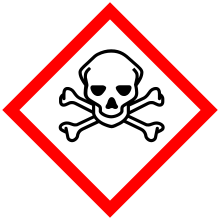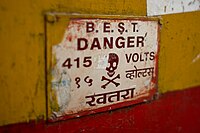Skull and crossbones (symbol)
This article needs additional citations for verification. (April 2015) |
| ☠ | |
|---|---|
Skull and crossbones | |
| In Unicode | U+2620 ☠ SKULL AND CROSSBONES (HTML ☠) |
| Related | |
| See also | U+2623 ☣ BIOHAZARD SIGN (HTML ☣)U+2622 ☢ RADIOACTIVE SIGN (HTML ☢) |
A skull and crossbones is a symbol consisting of a human skull and two long bones crossed together under or behind the skull.[1] The design originated in the Late Middle Ages as a symbol of death and especially as a memento mori on tombstones.
In modern contexts, it is generally used as a hazard symbol that warns of danger, usually in regard to poisonous substances, such as deadly chemicals.[1]
Military use[]
The skull and bones are often used in military insignia, such as the coats of arms of regiments.[citation needed]
Symbol for poisonous substances[]

In 1829, New York State required the labeling of all containers of poisonous substances.[2] The skull and crossbones symbol appears to have been used for that purpose since the 1850s. Previously a variety of motifs had been used, including the Danish "+ + +" and drawings of skeletons.[citation needed]
In the 1870s poison manufacturers around the world began using bright cobalt bottles with a variety of raised bumps and designs (to enable easy recognition in the dark) to indicate poison, but by the 1880s the skull and cross bones had become ubiquitous, and the brightly coloured bottles lost their association.[citation needed]
Gallery[]

A skull and crossbone arrangement in the Sedlec Ossuary, Czech Republic.

Skull and crossbones as a charge in heraldry on the coat of the 8th Lusitania Cavalry Regiment
An early 17th-century "plague panel" from Augsburg

High voltage sign from Saudi Arabia

Skull and crossbones on a sign warning of high voltage in Mumbai, India

EU standard toxic symbol, as defined by Dangerous Substances Directive (67/548/EEC)

Skull and crossbones sign mounted on a power box in Poland
See also[]
- Danse Macabre
- Death's Head
- Hazard symbol
- Human skull symbolism
- Jolly Roger
- Mr. Yuk
- Ossuary
- Totenkopf
References[]
- ^ Jump up to: a b "Dictionary and Thesaurus". Merriam-webster.com.
- ^ Griffenhagen, George B.; Bogard, Mary (19 November 1999). History of Drug Containers and Their Labels. Amer. Inst. History of Pharmacy. ISBN 9780931292262. Retrieved 19 November 2017 – via Google Books.
External links[]
| Look up skull and crossbones in Wiktionary, the free dictionary. |
 Media related to Skull and crossbones at Wikimedia Commons
Media related to Skull and crossbones at Wikimedia Commons
- Cross symbols
- Hazards
- Heraldic charges
- Personifications of death
- Pictograms
- Visual motifs







